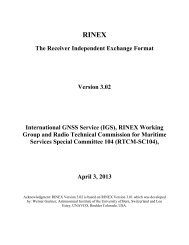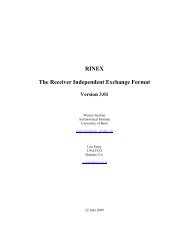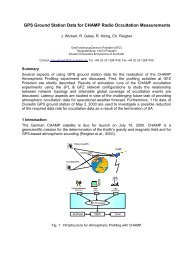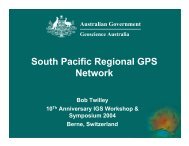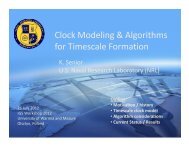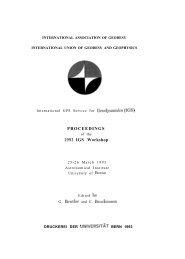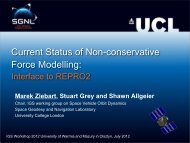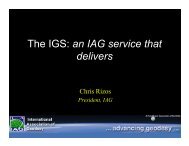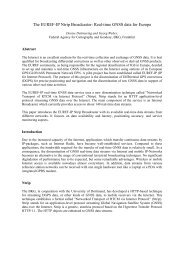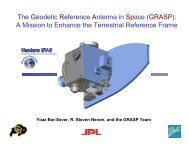IGS Analysis Center Workshop - IGS - NASA
IGS Analysis Center Workshop - IGS - NASA
IGS Analysis Center Workshop - IGS - NASA
You also want an ePaper? Increase the reach of your titles
YUMPU automatically turns print PDFs into web optimized ePapers that Google loves.
1. introductionThe main objectives of the International GPS Service for Geodynamics (<strong>IGS</strong>) is to produce preciseGPS orbits and to contribute GPS Earth Orientation Parameter (EOP) solutions to the InternationalEarth Rotation Service (IERS). The IERS, in return is responsible for combining various EOP andstation coordinate solutions, based on different and independent techniques, into a single EOPseries and the corresponding station coordinate sets in the International Terrestrial ReferenceFrame (ITRF). Currently no ‘official’ product is issued by the <strong>IGS</strong>. The <strong>IGS</strong> could, however,provide a logical and an efficient extension of the ITRF through the definition of <strong>IGS</strong> orbits plusthe timely approximation and resolution enhancements of the IERS EOP series (e.g. the IERSRapid Service). It is clear that orbits, station positions and EOP must be made as compatible aspossible. This is the main reason why there is such close cooperation with IERS both at theoperational and management levels (observation and processing standards, governing boards,terms of references, etc.).The <strong>IGS</strong> orbit should be more precise than most if not all the individual orbit solutions contributedto <strong>IGS</strong>, but more importantly it should also be more reliable and more consistent with IERWTRF.Besides, an ‘official’ <strong>IGS</strong> orbit makes an easier choice for uninitiated users, or for the users whoseek officially sanctioned products, results or reference. The <strong>IGS</strong> orbits could only be available asfast as the slowest contributing <strong>Center</strong>, thus strict submission deadlines are required and have to beenforced by <strong>IGS</strong>. For this reason alone, or due to scientific, regional or political considerationsindividual <strong>IGS</strong> <strong>Center</strong> orbits may still be preferred by some users, and thus it is suggested that theywill be archived and made available to the <strong>IGS</strong> users as well, in the same fashion as currently doneby IERS for all the contributed EOP series.Orbit combination by itself and as such would not be required if the processing standards, themodelling and the data sets used by different <strong>Center</strong>s were identical, and if the different softwaresystems were consistent and compatible (different software systems under identical conditionsshould ideally give the same results). In this ‘ideal’ case a single (<strong>IGS</strong>) orbit could be produced bya single <strong>Center</strong> and the role of additional <strong>Center</strong>s would be that of providing back up, redundancyand security. Such <strong>IGS</strong> products may then be far from ideal, though, as they can be biased by thesame amount due to e.g. inadequate ‘standard’ modelling. For this reason, as well as to give the <strong>IGS</strong><strong>Center</strong>s some room for improvements and innovations, it is suggested that some latitude withinreasonable processing guidelines and standards is desirable and allowed. It is hoped that all <strong>Center</strong>smay not be affected and/or failing in the same way at the same time. Then, some strategies andconsiderations for orbit combinations need to be considered as some small differences in orbits willexists even with the same software, data or similar estimation approaches. Another extreme caseis a rigorous distributed processing, where data from different periods/regions are combinedrigorously, e.g. at the normal matix stage in a similar fashion as it was done for the NAD83 andother continental geodetic network adjustments. A rigorous combination of GPS processing ismore complicated due to common satellite and station clock biases and requires some unique andcomplex strategies. As seen from the previous discussions, an <strong>IGS</strong> (orbit) product combination,strictly speaking, involves all the other topics of this workshop, namely the <strong>IGS</strong> formats,processing standards and distributed processing. It is also desirable that by January 1, 1994 whenthe <strong>IGS</strong> service becomes operational, some realistic and practically achievable orbit combinationis established and results made available in a timely fashion.In the first orbit combination approach all the submitted orbits are first transformed to a commonreference frame consistent with IERS/ITRF and then combined by a weighted mean. This is the21




